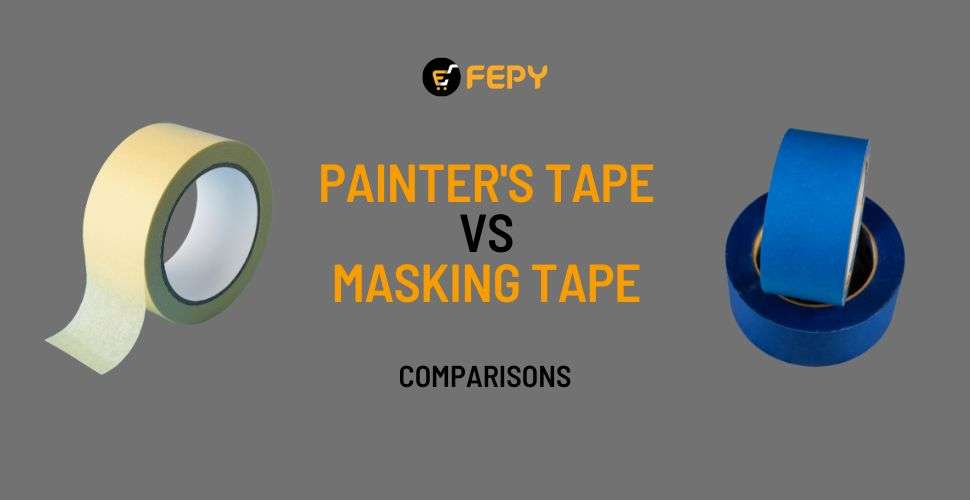Masking Tape vs Painter's Tape: What's the Difference

Masking tape and painting tape are similar yet different. Understanding the distinction between masking and painter's tape is the key to achieving a flawless, professional-looking finish. At first glance, these two tapes might seem like identical twins with their crepe paper backing. However, a closer inspection reveals crucial differences that can significantly impact your painting project.
Masking Tape vs Painter's Tape: Key Difference
The adhesive is the biggest differentiator between these two tapes.
Masking tape boasts a powerful grip, designed to hold firmly and resist budging. It makes it perfect for tasks like labeling containers or securing lightweight objects.
However, this strength comes with a drawback. Removing masking tape leaves behind a sticky residue. This residue can be a hassle to clean, so it's best suited for applications where the tape needs to stay longer.
Painter's tape, on the other hand, prioritizes clean lines and effortless removal. Its specialized adhesive has a lower tack, allowing you to remove it without peeling off paint or leaving any unwanted residue.
It makes it the champion for creating sharp paint edges, a favorite amongst DIY enthusiasts and professional painters.
Masking Tape is cheaper than Painter's Tape. And, sometimes, it affects the preferability.
Painter's Tape vs Masking Tape: Comparisons

While masking and painter's tape may seem like close relatives, they each possess unique strengths that make them ideal for specific tasks. Let's dive deeper into these crucial characteristics:
Purpose:
Masking tape is a versatile champion, tackling everyday household jobs and adhering to consistent temperatures.
In contrast, painter's tape is a specialist designed to excel in painting applications, both indoors and outdoors.
Effectiveness:
Patience is vital when using masking tape for painting. To avoid leaving any residue or peeling off the paint, remove it within hours.
Painter's tape score is higher when it comes to patience. It can last for days on surfaces like walls, windows, and floors without leaving a sticky mess upon removal.
Durability:
Water-based paints can wreak havoc on masking tape, causing it to wrinkle or disintegrate, leaving your project vulnerable to drips.
Oil-based paints can also be a nemesis, seeping through the tape and creating unwanted marks.
Painter's tape is the stoic hero in this scenario. It maintains its composure and prevents the paint from bleeding through.
Applications:
Masking tape undoubtedly earns its place in the toolbox. While not explicitly designed for painting, it can be used in a pinch for small projects. However, be prepared for some potential touch-ups due to paint bleed or minor peeling during removal.
The affordability of masking tape makes it an attractive option, but for a truly professional finish with minimal cleanup, consider investing in painter's tape.
Beyond its impressive staying power, painter's tape boasts several other advantages. It's resistant to both water-based and oil-based paints, preventing them from seeping through.
The versatile nature of painter's tape extends to its ability to handle high temperatures, making it ideal for various painting projects.
Usability:
Masking tape is often made from thicker cloth or crepe paper, making it less adept at following curves and more likely to leave jagged edges.
Painter's tape, on the other hand, is meticulously crafted for razor-sharp results. In this case, the material is washi paper, which is thin and flexible. It conforms beautifully to curved surfaces – a must for intricate details like car pinstripes or custom finishes on walls.
Conformability:
Water-based paints can pose a significant threat to masking tape. Its natural rubber adhesive can react poorly, causing the tape to buckle and allowing the paint to seep.
Painter's tape emerges victorious in this battle with its superior conformability. The paint stays firmly in place without puckering, even when with water-based paints.
Residues:
Masking tape's strong adhesive is a double-edged sword. It provides a secure hold for general tasks, but it often leaves a residue behind after removal.
Painter's tape, however, boasts a unique low-tack adhesive that removes cleanly, leaving no sticky mess behind. You can even leave it on surfaces for up to 14 days without worrying about damage.
Specific Applications:
While both tapes share the goal of protecting surfaces during painting, their applications extend further.
With its versatility, Masking tape finds uses in general tasks like fixing, binding, and sealing.
A painter's tape is ideal for projects that require sharp color distinctions since it creates clean lines.
The distinctive blue or green hues of painter's tape aren't just for aesthetics. During application, these colors stand out against most paint colors.
While painter's tape might cost slightly more than masking tape, the time saved on touch-ups and cleanup often makes it a worthwhile investment.
Masking Tape vs Painter's Tape: Comparison Table
|
Feature |
Masking Tape |
Painter's Tape |
| Adhesive Strength |
Strong | Low-Tack |
| Residue Upon Removal |
Likely |
None |
| Best for |
General tasks, temporary fixes, labeling |
Painting (both indoors & outdoors) |
| Water Resistance |
Can buckle or allow paint to seep through |
Stays put without puckering, even with water-based paints |
| Oil Resistance |
May not fully resist oil-based paints |
Resists both water-based and oil-based paints |
| Material |
Cloth or crepe paper |
Flexible washi paper |
| Conformability |
Less conformable (may not follow curves well) |
Highly conformable (ideal for curved surfaces) |
| Clean Lines |
Difficult to achieve | Easy to achieve due to thinness |
| Color |
Off-white |
Typically, blue or green |
| Removal Time |
Should be removed within hours |
Can stay on up to 14 days |
| Applications |
General tasks, fixing, binding, temporary fixes |
Painting (especially for crisp lines), creating color separation |
| Cost | Cheaper |
More expensive |
|
Overall |
Versatile but may require touch-ups for painting |
Ideal for achieving professional-looking paint jobs |
FAQs
Q. Can I use regular tape instead of masking tape for painting?
Experts advise against using regular tape for painting. It's likely to leave a stubborn residue and damage the surface when removed. Masking tape, with its weaker adhesive, is specifically formulated for temporary application and easier removal.
Q. Which is cheaper, masking tape or painter's tape?
Masking tape is generally less expensive than painter's tape. However, the cost savings might not outweigh the frustration of potential paint bleed or residue removal with masking tape. Painter's tape provides a flawless finish with minimal cleanup.
Q. Is masking tape the same as painter's tape?
Not quite. Masking tape is a broad category that includes painter's tape. Painter's tape is a specialized type of masking tape designed specifically for painting applications, with features like a low-tack adhesive for clean removal and backing that conforms well to surfaces.
Final Words
It's time to make informed decisions for your next painting project now that you've unmasked the mysteries of masking and painter's tape. Remember, masking tape is your go-to for general tasks. In contrast, painter's tape champions achieving clean, professional-looking paint jobs. The best part is that you can easily order all types of tapes at the most affordable price at FEPY. FEPY is the UAE's leading e-commerce platform for construction materials.




